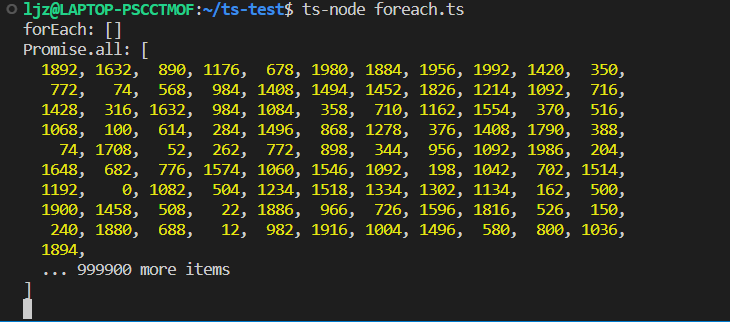
为什么forEach不支持async/await
forEach、Promise.all和for…of
在下面的代码中forEach、Promise.all和for…of会表现出不同的结果
function sleep(ms: number) {
return new Promise(resolve => setTimeout(resolve, ms));
}
async function processItem(item: number) {
// Simulate a long-running asynchronous operation
await sleep(Math.random() * 100);
return item * 2;
}
async function testForEach(array: number[]) {
const result: number[] = [];
array.forEach(async item => {
const processed = await processItem(item);
result.push(processed);
});
console.log("forEach:", result);
}
async function testPromiseAll(array: number[]) {
const promises = array.map(processItem);
const result = await Promise.all(promises);
console.log("Promise.all:", result);
}
async function testForOf(array: number[]) {
const result: number[] = [];
for (const item of array) {
const processed = await processItem(item);
result.push(processed);
}
console.log("for...of:", result);
}
const array = Array.from({ length: 1000000 }, () => Math.floor(Math.random() * 1000));
testForEach(array);
testPromiseAll(array);
testForOf(array);
结果:使用foreach并没有等待异步操作完成;使用Promise.all同时开启了多个异步操作并等待这些异步操作完成;使用for…of则是一个一个的顺序执行异步操作,因此花费了更长的时间。
为什么forEach不支持async/await
通过以上例子我们可以看到,forEach只支持同步,不支持异步。
这是因为forEach是没有return返回值的,forEach里面的回调函数因为加了async,所以默认会返回一个promise,但是因为forEach的实现并没有返回值,所以导致返回的这个promise对象不能被处理。
而map也是跟forEach是一样的,在map中使用async/await,同样也是不能等待异步操作的完成。
而Promise.all的返回不是void也不是promise<void>,而是promise<T>,所以可以等待异步操作完成。
// 下面代码会输出和forEach一样的结果
async function testMap(array: number[]) {
const result: number[] = [];
array.map(async item => {
const processed = await processItem(item);
result.push(processed);
});
console.log("map:", result);
}
总结
- forEach、map: forEach或map方法遍历数组,并为每个元素启动一个异步操作,但是不会等待异步操作的完成。
- Promise.all 方法将所有的异步操作并行执行,并等待所有的操作完成。这种方法可以最大限度地利用 CPU 和 IO 资源,因此可以更快地处理数据。
- for…of 循环遍历数组,并在每个元素上执行异步操作。由于 for…of 循环是一个同步方法,它会等待每个异步操作完成,然后才会继续执行下一个操作。这种方法可能会比 Promise.all 方法慢,但是它可以避免一次性处理过多的数据,从而提高系统的稳定性。
